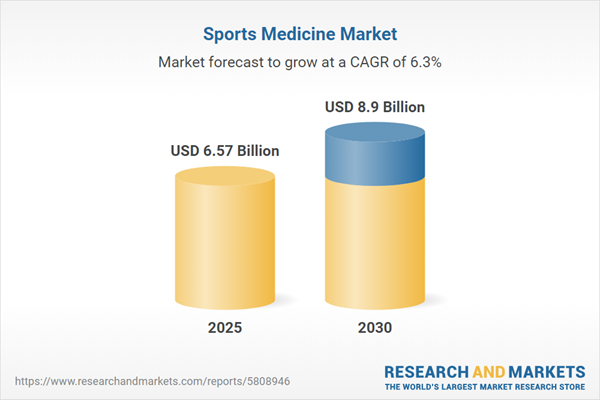The sports medicine market is projected to experience significant growth from 2025 to 2030, driven by increasing sports participation, rising awareness of injury prevention, and advancements in medical technologies. This comprehensive report segments the market by function, application, and geography, offering detailed insights through Porter’s Five Forces and industry value chain analyses. It also examines regulatory frameworks and competitive dynamics, equipping stakeholders with critical information to navigate this evolving sector.
Market Drivers
Growing Sports Participation and Injury Awareness
The global rise in sports and fitness activities, coupled with heightened awareness of injury prevention and recovery, is a primary driver of the sports medicine market. Athletes, both professional and amateur, are increasingly seeking advanced medical solutions to maintain peak performance and recover from injuries. This demand is fueling the adoption of sports medicine products and services, particularly in areas like reconstruction and body monitoring, as individuals prioritize long-term health and performance.Technological Advancements
Innovations in medical technologies, such as minimally invasive surgical techniques, wearable monitoring devices, and regenerative therapies, are propelling market growth. These advancements enhance the precision and effectiveness of treatments for sports-related injuries, improving recovery times and outcomes. The integration of smart technologies, such as AI-driven diagnostics and real-time monitoring, is further transforming the market, catering to the needs of athletes and healthcare providers alike.Market Challenges
The sports medicine market faces challenges, including high costs associated with advanced treatments and devices, which may limit accessibility in developing regions. Stringent regulatory requirements for medical devices and therapies can also delay product approvals and market entry. Additionally, the need for specialized expertise to implement advanced sports medicine solutions poses a barrier for widespread adoption in some markets.Market Segmentation
By Function
The market is segmented by function into reconstruction, support and recovery, body monitoring and evaluation, and others. Reconstruction, including procedures like arthroscopy, holds a significant share due to the prevalence of joint injuries among athletes. Body monitoring and evaluation, driven by wearable technologies, is gaining traction for its role in injury prevention and performance optimization.By Application
Applications include knee, shoulder, hip, spine, and others. Knee injuries, being among the most common in sports, dominate the market, with demand for ligament repair and cartilage regeneration solutions. Shoulder and hip applications are also significant, driven by the need for surgical and non-surgical interventions to address sports-related wear and tear.Geographical Outlook
North America: Market Leader
North America, particularly the U.S., dominates the sports medicine market due to its advanced healthcare infrastructure, high sports participation rates, and strong investment in R&D. The region’s focus on professional sports and fitness culture drives demand for cutting-edge solutions, supported by favorable reimbursement policies and regulatory frameworks.Asia Pacific: Rapid Growth
Asia Pacific is expected to witness the fastest growth, fueled by increasing sports participation, rising disposable incomes, and government initiatives promoting fitness in countries like China and India. The region’s expanding healthcare sector and growing adoption of advanced medical technologies are creating significant opportunities for market expansion.Competitive Landscape
The report maps key players on a vendor matrix across four quadrants: leader, follower, challenger, and niche. Leading companies are investing in innovative products, such as regenerative therapies and smart wearables, while forming strategic partnerships to enhance market presence. Regulatory compliance and product differentiation remain critical for maintaining competitive advantage.Conclusion
The sports medicine market from 2025 to 2030 is set for robust growth, driven by rising sports participation, technological advancements, and increasing injury awareness. North America leads, while Asia Pacific emerges as a high-growth region. Despite challenges like high costs and regulatory hurdles, the market’s focus on reconstruction, monitoring, and applications like knee and shoulder treatments offers substantial opportunities for stakeholders to capitalize on evolving healthcare and fitness trends.Key Benefits of this Report:
- Insightful Analysis: Gain detailed market insights covering major as well as emerging geographical regions, focusing on customer segments, government policies and socio-economic factors, consumer preferences, industry verticals, and other sub-segments.
- Competitive Landscape: Understand the strategic maneuvers employed by key players globally to understand possible market penetration with the correct strategy.
- Market Drivers & Future Trends: Explore the dynamic factors and pivotal market trends and how they will shape future market developments.
- Actionable Recommendations: Utilize the insights to exercise strategic decisions to uncover new business streams and revenues in a dynamic environment.
- Caters to a Wide Audience: Beneficial and cost-effective for startups, research institutions, consultants, SMEs, and large enterprises.
What do businesses use our reports for?
Industry and Market Insights, Opportunity Assessment, Product Demand Forecasting, Market Entry Strategy, Geographical Expansion, Capital Investment Decisions, Regulatory Framework & Implications, New Product Development, Competitive IntelligenceReport Coverage:
- Historical data from 2022 to 2024 & forecast data from 2025 to 2030
- Growth Opportunities, Challenges, Supply Chain Outlook, Regulatory Framework, and Trend Analysis
- Competitive Positioning, Strategies, and Market Share Analysis
- Revenue Growth and Forecast Assessment of segments and regions including countries
- Company Profiling (Strategies, Products, Financial Information, and Key Developments among others).
The sports medicine market is analyzed into the following segments:
By Function
- Reconstruction
- Support and Recovery
- Body Monitoring and Evaluation
- Others
By Application
- Knee
- Shoulder
- Hip
- Spine
- Ankle
- Others
By Geography
- North America
- United States
- Canada
- Mexico
- South America
- Brazil
- Argentina
- Others
- Europe
- United Kingdom
- Germany
- France
- Spain
- Others
- The Middle East and Africa
- Saudi Arabia
- UAE
- Israel
- Others
- Asia Pacific
- Japan
- China
- India
- South Korea
- Indonesia
- Thailand
- Others
Table of Contents
Companies Mentioned
- Arthrex
- Smith & Nephew
- J&J MedTech
- Stryker Corporation
- CONMED Corporation
- Zimmer Biomet
- DonJoy
- Mueller Sports Medicine
- Karl Storz
Table Information
| Report Attribute | Details |
|---|---|
| No. of Pages | 149 |
| Published | July 2025 |
| Forecast Period | 2025 - 2030 |
| Estimated Market Value ( USD | $ 6.57 Billion |
| Forecasted Market Value ( USD | $ 8.896 Billion |
| Compound Annual Growth Rate | 6.2% |
| Regions Covered | Global |
| No. of Companies Mentioned | 9 |









